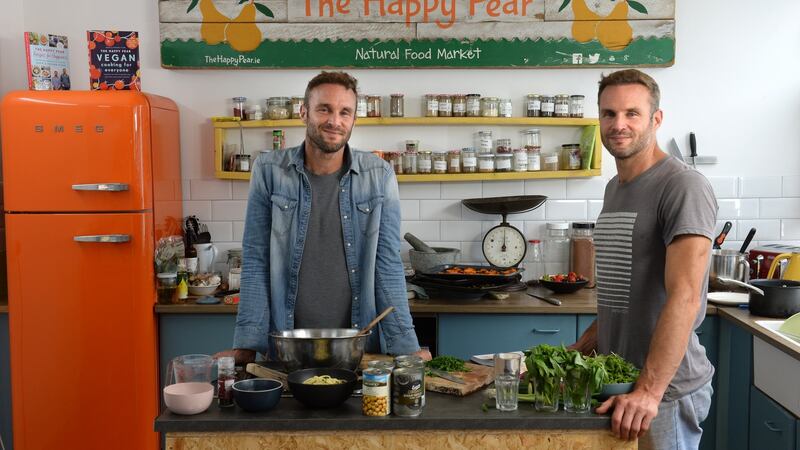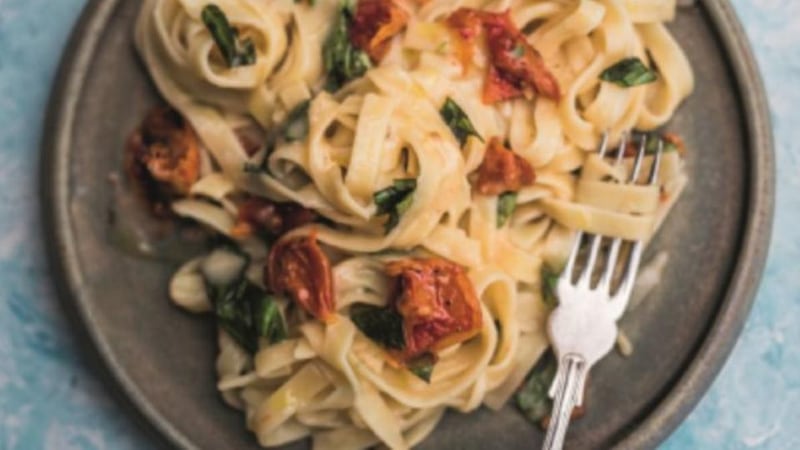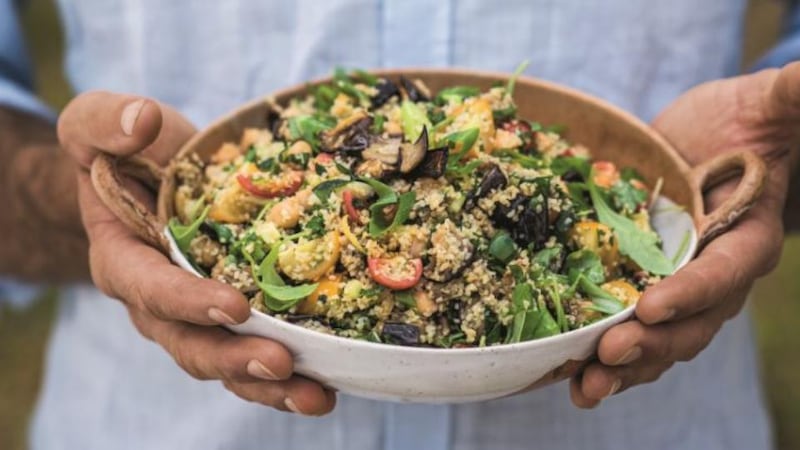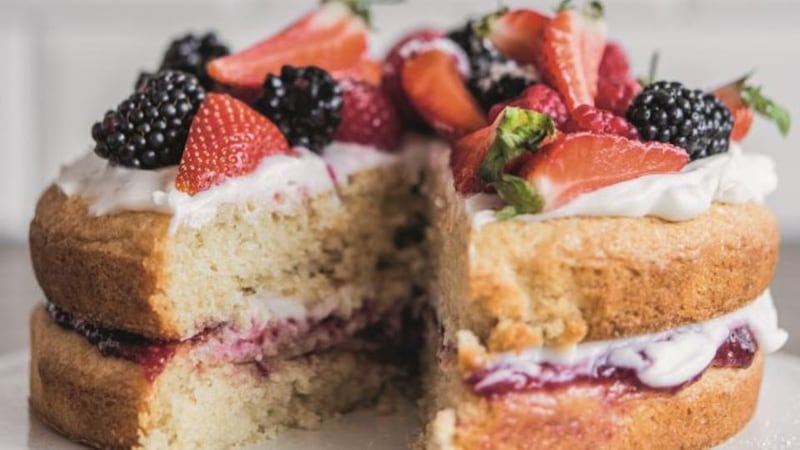"It's the first book we've done without handstands or topless shots." Almost 20 years since the perennially popular twins behind the Happy Pear vegan food brand took their first steps into the Irish food scene, Stephen and David Flynn have published their fourth cookbook.
Vegan Cooking for Everyone is different, in lots of ways. Apart from an absence of “money shots”, the duo are conspicuous by their absence from the cover too. “Not being on the cover was a point of friction initially, but now that I see it, I think it’s beautiful,” Stephen says of the vine tomato illustration that graces the cover of the collection of 200 recipes. “We’ve been on the front cover of the other three books. This one has got to sell because of the quality of the book, not because our faces are known.”
The identical twins, who live “a stone’s throw” from their cafe, food shop and soon-to-open sourdough bakery, in Greystones, Co Wicklow, turned 40 last December. They celebrated with birthday cake on the beach after their daily dawn sea swim, and took their mother out to lunch.
The new book, which they say is more about getting people to eat more vegetables and fruit than converting them to veganism, is part of a new, more mature direction for the pair. David describes it as being “more substantial” than their previous books.
Stephen goes further: “On a personal level, when we first started getting out there, we were a bit insecure and afraid to show any substance. We were caught behind the veil of silliness, and it’s only with maturing I have more confidence to reveal there is actually a more serious side to me, that I’m not as afraid to show any more. There’s more depth, as opposed to this frivolous, excited duo.”
“Puppy dogs,” David chimes in, in the habit they have of finishing and embellishing each other’s sentences, and underlining that they don’t take themselves too seriously.

With maturity come hard decisions too, and the pair recently closed their cafe in Clondalkin. "The bottom line is it had been losing money, it couldn't sustain itself financially and corona just knocked the wheels off it," David says.
Their Greystones cafe and shop, Dublin Airport outlet, food product manufacturing plant and coffee roastery in Kilcoole, and online cooking and healthy living courses will continue to be their focus for the foreseeable, and they have no major retail expansion plans, beyond the sourdough bakery soon to open in Greystones.
“We’re more focused on doing less and doing it better,” David says. Further down the line, they would like to buy a farm, to grow their own crops, and involve schools and the local community in their endeavours.
The twins' initial conversion to plant-based eating in their early 20s is well documented – they made the change in the same week, without discussing it with each other, while on opposite sides of the globe. David was in South Africa training to be a golf pro and Stephen was in Whistler in Canada, hoping to become a snow board instructor and working in a burger bar up the mountain.
We've learned to be less fundamental about it. I think children tend to soften you
They’ve been evangelical about their lifestyle choice since then, becoming virtual poster boys for plant-based eating. So it comes as a surprise when I ask if their children – they have five between them, between the ages of three and nine – are vegan.
“No,” they chorus. “My wife is Polish,” Stephen says, “and when Justyna was pregnant with May, I was adamant I wanted to raise her vegan. But my mother-in-law is very traditional, they slaughter their own animals, they have them in the garden. You want chicken for lunch, she goes out and you know, plucks the chicken there, literally for lunch. And so, good luck telling my mother-in-law May’s vegan.”
David’s experience is similar. “The straight answer is no. When they’re with us we very much feed them a vegan diet and encourage them to eat it. But when they’re out, they do their own thing. They love a sausage and love burgers just like most kids.”
Stephen says: “We’ve learned to be less fundamental about it. I think children tend to soften you. For many years, I was extremely rigid. Granny would make a beautiful Victoria sponge or apple pie and I’d be ‘No granny, I’m vegan.’ Over the years, you kind of realise...‘Yes Granny, I’d love a slice’.”
And would you eat it?
“Absolutely, because my granny made it. If it was meat, I wouldn’t eat it, but you’ve got to draw your own boundaries, no one is perfect.”
Their own boundaries, while committed to plant-based eating, aren’t as rigid as they once were. “I ate a raw food diet for a year and I was extremely healthy, but I was neurotic and I excluded myself from a lot of society, so for both of us, we’ve kind of learned how to navigate it in the most sustainable way possible,” Stephen says.
“It’s not a religion, it’s a lifestyle. Our message isn’t to make anyone vegan or vegetarian, it genuinely is to make everyone eat more fruit and veg and to eat more wholefoods,” David adds.
The Happy Pear: Vegan Cooking for Everyone, by David and Stephen Flynn, is published by Penguin Life, £20.
CHEESY BASIL AND SUN-DRIED TOMATO PASTA

Serves one
This sauce is based on the Italian dish cacio e pepe (cheese and pepper), where the sauce is made with just cheese, pasta cooking water and black pepper. A good trick for adding more flavour is to reduce the amount of water you cook the pasta in. Usually the ratio of pasta to water is 1:10, so for example, 100g of pasta would normally be cooked in 1,000ml (1 litre) of water. However, if you cook the pasta in less water – for example, using a 1:5 ratio (100g of pasta cooked in 500ml of water) – it means the pasta cooking water will be more intensely starchy, which will make it easier to form a creamy sauce, and it will be more salty too.
Ingredients
100g pasta per person
45g grated vegan Parmesan per person
10g fresh basil leaves per person
30g sun-blushed tomatoes per person
Method
1 Cook the pasta in a large pot of boiling salted water according to the packet instructions until al dente, but first make sure that you work out the 1:5 ratio of pasta to cooking water based on how many portions of pasta you're making. Drain the pasta in a colander set over a separate large pot so that you can reserve all the cooking water. Set the pasta aside and continue to boil the pasta water for a further 2 minutes to concentrate the starch.
2 Put the cooked pasta into its original large pot along with the cheese and basil. Slowly add the reduced pasta water a little at a time until the sauce starts to come together. As you stir, try to bang the pasta off the sides of the pot so that the pasta releases its starch and this creates an emulsion with the melted cheese. A silky-smooth sauce should start to form.
3 Taste and adjust the seasoning with a little more salt if needed, though it will probably be salty enough from the reduced cooking water and the cheese.
4 Stir in the tomatoes, then divide the pasta between wide, shallow bowls and serve straight away, with extra vegan Parmesan on the side for sprinkling over.
TABBOULEH CHICKPEA SALAD

Serves two to four
Ingredients
250g cooked bulghur wheat
1 × 400g tin of chickpeas
100g cherry tomatoes, halved
50g spring onions, thinly sliced
50g cucumber, diced
150g roasted aubergines, chopped into bite-sized pieces
100g rocket
1 large bunch of fresh flat-leaf parsley
1 bunch of fresh mint
Salt and freshly ground black pepper
Dressing:
50ml olive oil
Juice of 1 lemon
1tbsp tamari or soy sauce
Method
1 Roast the aubergines in the oven at 200 degrees Celsius fan/425°F/gas 7 for 25-30 minutes. You want to make sure you cook them until they are super soft, with a melt-in-your-mouth texture.
2 Combine 1 part bulghur wheat with 2 parts water and a pinch of salt in a saucepan. Bring to the boil, then cover the pan, reduce the heat and simmer for about 12 minutes, until all the water has evaporated and the bulghur is tender. Drain any excess water, then fluff up the bulghur with a fork.
3 Drain and rinse the chickpeas.
4 Half the tomatoes, thinly slice the spring onions and dice the cucumber.
5 Finely chop the parsley, including the stalks. Finely chop the mint after removing the stalks.
6 To make the dressing, blend all the dressing ingredients together.
7 Now think about presentation. In a large serving bowl, start with the wheat, then add the chickpeas and raw veg. Drizzle over the dressing, then add the aubergine, rocket and herbs and gently mix through. Add the salt and pepper, then taste and adjust if needed.
VICTORIA SPONGE CAKE

Makes one
Ingredients
Dry ingredients:
400g plain white flour
300g caster sugar
2tbsp baking powder
½tsp baking soda
Wet ingredients:
200ml unsweetened almond milk
200ml neutral-tasting oil
1tsp vanilla extract
1tbsp apple cider vinegar
Filling and decoration:
2 × 400ml tins of full-fat coconut milk
1tbsp maple syrup
½tsp vanilla essence
100g raspberry jam
Fresh berries
Method
1 Preheat the oven to 180°C fan/400°F/gas 6. Grease and line 2 × 20cm springform cake tins with non-stick baking paper.
2 Put the tins of coconut milk for the frosting into the fridge to allow the cream to separate and harden.
3 Mix all the dry ingredients together in a bowl, then sift them through a fine mesh sieve into a separate large bowl. Make a well in the centre.
4 Mix all the wet ingredients together, then add to the well in the centre of the dry ingredients. Using a spatula or a hand mixer, mix together until just combined.
5 Divide the mixture evenly between the two tins and bake in the preheated oven for 30 minutes, rotating the tins halfway through the cooking time to ensure they cook evenly. When done, a skewer inserted into the centre should come out clean; if not, they need to go back in the oven for a little longer, until the skewer comes out dry. Remove the cakes from the oven and set aside on a wire rack to cool in the tins for 10 minutes before turning out and allowing to cool completely before frosting.
6 Remove the tins of chilled coconut milk from the fridge, taking care not to shake the tins. Spoon off the hardened cream at the top of the tins and place in a bowl with the maple syrup and vanilla, mixing until smooth but being careful not to overmix, otherwise it can start to clump and slightly curdle.
7 Put one cooled cake on a cake stand or serving plate and add the jam filling to the top of the cake, spreading it evenly but not all the way to the edge, leaving about 1cm clear. Add half the cream, then, working your way out from the centre, spread it nearly to the edge in an even layer. Place the second cake on top, pressing it down lightly so the filling just comes to the edge. Then add your top layer of cream to the top of the cake, again working your way from the centre, spreading the cream to the edge. Decorate with fresh berries and cut into slices to serve.










